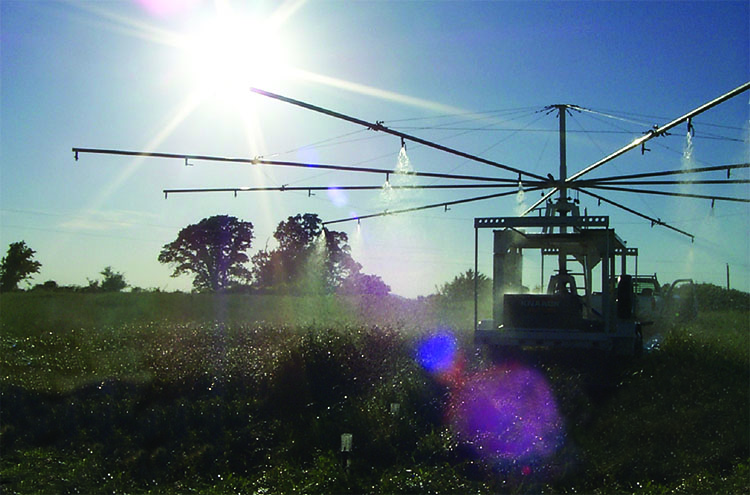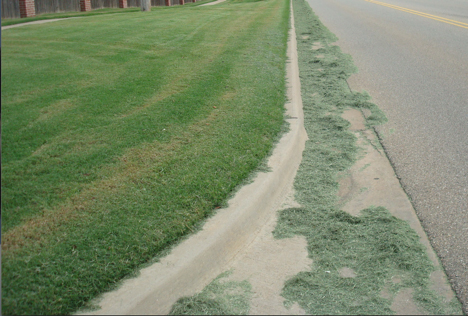Phosphorus and Water Quality
The 2014 Integrated Water Quality Assessment Report by the Oklahoma Department of Environmental Quality (http://www.deq.state.ok.us/WQDNew/305b_303d/2014/2014_OK_IR_document-Final_w_appendices.pdf) showed 204 miles of Oklahoma streams were impaired by phosphorus (P) and nitrogen (N), and 29,351 acres of lake were impaired by total P. The pollutants of concern were attributed to agriculture, urban storm water and other sources.
Phosphorus is the plant nutrient most often responsible for impairment of surface water. It is essential for healthy, productive crops and most agronomic systems call for application of commercial fertilizer or animal manure to correct soil phosphorus deficiencies. For agronomic, economic and environmental reasons, application of phosphorus is not recommended, however, where soil tests show phosphorus reserves are adequate for the intended crop.
Phosphorus is typically not considered a groundwater pollutant. Further, most soils have the capacity to retain phosphorus in the upper layers, protecting the groundwater.
Concerns about Phosphorus in Water
Excess phosphorus is a concern for most aquatic ecosystems. Under background conditions, where human activities do not dominate the landscape, phosphorus is generally in short supply. Its absence limits the growth of algae and aquatic plants. When additional phosphorus becomes available to the aquatic system, it stimulates the growth of algae and other aquatic plants. This condition of nutrient enrichment and high plant productivity is referred to as eutrophication.
Under eutrophic conditions, recreational values of lakes and streams may suffer. In the early stages of eutrophication, fishing may improve because productivity increases the food supply. But when these algae and aquatic plants die, their decomposition consumes oxygen, causing fish kills and undesirable conditions.
Another undesirable effect of eutrophication is the growth of blue-green algae. These algae gain a competitive advantage and tend to dominate the algal community where phosphorus is in excess. They are a particular concern because they release odiferous and even toxic compounds. Their presence at high concentration (called bloom conditions) generally results in odor and taste problems in drinking water and allergic and even toxic effects for those who come in contact with them. Blue-green algae blooms in Oklahoma ponds have caused cattle death.
Improving water quality in a lake impaired by excessive phosphorus is difficult because phosphorus accumulates in the sediments and biota in addition to the water body. Consequently, it may take years after phosphorus sources have been reduced or eliminated for conditions to improve. Therefore, it is important to take preventive steps to limit phosphorus movement into surface waters.
Eutrophication
Lakes and ponds naturally support a healthy population of aquatic life. But if nutrient levels, especially phosphorus, become too high, production of algae and aquatic plants increases and the following undesirable changes can occur:
- Excessive algae growth
- Reduced water clarity
- Unpleasant odor and taste
- Low dissolved oxygen
- Changes in fish populations or fish kills
- Toxins from bluegreen algae
Particulate and Dissolved Phosphorus
In the environment, phosphorus may be in dissolved or particulate forms. Dissolved phosphorus is readily available to aquatic organisms. It may be a result from leaching of fertilizer, crop residues or human or animal wastes. A small amount of dissolved phosphorus exists naturally in soils. This may be transferred to runoff water by exchanges with the top layer of the soil. Recently applied fertilizer or manure still on the soil surface can be a particularly large source of dissolved phosphorus if runoff takes places.
Particulate phosphorus may be associated with soil particles and minerals containing aluminum, iron or calcium or with organic matter, like plant or animal materials. Particulate phosphorus moves primarily by soil erosion or wash off from the land surface. Whereas dissolved forms of phosphorus are readily available to algae, particulate phosphorus may be unavailable or slowly available to aquatic organisms. Where particulate phosphorus has accumulated in streambeds and lakebeds, gradual release of dissolved phosphorus from sediments can be a source of phosphorus for many years.
Sources of Phosphorus
Phosphorus comes from both point and nonpoint sources. Point sources include municipal waste treatment plants, industrial discharge, large confined livestock operations and urban stormwater. These sources are regulated by federal and state laws. They are generally required to have environmental controls, such as waste handling, treatment systems and nutrient management plans.
Nonpoint sources of phosphorus include soil erosion and water runoff from cropland, lawns and gardens, home waste treatment systems, livestock pastures, rangeland and even forests. Urban areas may produce significant nonpoint source phosphorus runoff due to over-application of fertilizer to lawns and gardens. Homeowners who apply fertilizer without a soil test eventually build up very high soil test phosphorus levels that can become significant sources of phosphorus in runoff. Most importantly, fertilizer, pet waste and lawn clippings left on driveways, sidewalks or streets are a direct source of pollution through storm drains in urban areas.
Factors that affect the level of nonpoint source phosphorus in runoff from cropland and pasture land include soil phosphorus concentration, or Soil Test Phosphorus (STP), the erosion rate and the application rate and timing of commercial fertilizer, composts or animal manure. Generally, high STP in the watershed results in high concentrations of particulate and dissolved phosphorus in runoff.
About 75 to 90 percent of phosphorus that moves into surface water from cropland is particulate phosphorus associated with eroded soil. In runoff from lawns, well-managed pasture and rangeland, where erosion is slight, almost all the phosphorus is dissolved.
Livestock congregating in riparian areas (the areas directly adjacent to streams) are also a significant source of phosphorus. This is a particular concern where animals are fed and watered in or near the stream.
Poorly designed or failing septic systems are also concerns with problems such as: discharging directly into streams or ditches, overloading the soil adsorption area or draining too quickly to groundwater and nearby surface waters. Such failing or poorly designed systems may discharge human waste, nutrients and pathogens directly into streams, lakes,or groundwater, creating significant public health problems in addition to nutrient enrichment.

OSU Researchers use rainfall simulator to investigate phosphorus BMPs for pasture systems.

Grass clips on streets can be washed to waterbodies and become nutrient source.

Fertilizer on sidewalks and driveways is a non-point source of pollution of nutrients.
Controlling Phosphorus Losses
Point sources of phosphorus, such as municipal and industrial waste treatment plants, are generally governed by federal and state regulations and permits. Urban and industrial stormwater and the storm sewer system of the larger cities are also regulated by federal and state permits.
Special rules are in place in Oklahoma for pollution control at animal feeding operations. Poultry producers and those who apply poultry litter to the land as fertilizer are subject to special rules requiring them to take continuing education each year and to follow nutrient management plans. Similar rules apply to operators of cattle- and hog-feeding operations. Nutrient management plans for animal waste are based on the USDA-NRCS (Natural Resources Conservation Service) 590 Conservation Practice Standard: Nutrient Management. More information on animal waste management is available from Agricultural Environmental Management Services Division at Oklahoma Department of Agriculture, Food and Forestry.
Nonpoint sources of phosphorus are not subject to regulation by state or federal agencies. Pollution control of runoff from cropland, pastures, forests and lawns and gardens largely depend on the voluntary use of Best Management Practices (BMPs). Technical assistance and, in some cases, cost share incentives are available from state and federal agencies to assist in implementing BMPs on farmland.
Many BMPs have been developed for application in both agricultural and urban areas. The purposes of those BMPs are to prevent phosphorus from build up in the soil (source factor), and to minimize phosphorus movement from land to water (transport factor). Assistance with these practices is available from the County Conservation District, the USDA-NRCS and the local county Extension office.
Best Management Practices to Control Phosphorus Loss
- Cropland and Pasture BMPs – Soil test and use only the amount of fertilizer or manure recommended. Follow the 4R principles of nutrient stewardship: right source, right rate, right time and right place. Crop production practices like banding, incorporating fertilizer below the soil surface near the plant, minimizes application rates and reduces runoff. Apply manure to pastures only when soils are not frozen and rainfall is not expected. Always leave a vegetated buffer down slope from fertilizer or manure application areas and around water resources.
- Erosion control BMPs. About 75 to 90 percent of phosphorus from cropland is attached to eroded soil particles. Consequently BMPs that reduce soil erosion, like no-till or reduced tillage cropping systems, terraces, and contour strip-cropping, reduce phosphorus loss substantially. Proper stocking rates for grazing systems on pasture and range, too, can reduce erosion and phosphorus loss.
- Livestock Production BMPs. Confined animal feeding operations (CAFOs) and dairies should be located away from waterways and surface drainage features. A Waste Management Plan, including waste collection, storage, transport and handling as well as nutrient management for application areas should be followed. Pasture management systems should include improved grazing systems, like rotational grazing and riparian management that restrict the access of livestock to streams and sensitive riparian areas.
- Homeowner BMPs. Proper design and maintenance of septic systems; soil testing for lawns and gardens periodically and apply only the nutrients recommended; cleaning up spilled fertilizer, grass clippings and pet wastes from driveways and side walks; and increasing infiltration with Bioretention cells, rain gardens and porous pavement are examples of urban and homeowner BMPs.
Hailin Zhang
Nutrient Management Specialist, Plant and Soil Sciences
